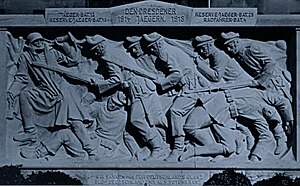Hunter's Monument (Dresden)
The hunters monument in Dresden was one and honorary and memorial to the victims and martyrs of the Dresdner hunters in the First World War .
Location
In the Johannstadt in Dresden the Jägerdenkmal was located on today's Sachsenplatz at the former main entrance of the Jäger barracks . This was located directly on the Albertbrücke to Sachsenallee (today Sachsenplatz) and Käthe-Kollwitz-Ufer (Hindenburgufer) and Florian-Geyer-Straße (Marschallstraße).
history
The barracks, built in 1882 according to plans by the Dresden architects Oswald Haenel , Bruno Adam and Fritz Opitz, were built as military protection for security at the Albertbrücke. The castle-like buildings fit in harmoniously with the existing buildings in the area. The longitudinal front to the Elbe was 134 meters, the side wings 82 meters. A parade house was on the south side. The guard, the detention rooms, several classrooms and service rooms as well as a casino for the chief hunters were housed on the ground floors. The crew rooms, washrooms and bedrooms as well as an officers' mess were on the upper floors. There were also rooms as storage rooms, workshops and apartments for professional soldiers. The hunters' kitchens and dining rooms and workshop rooms were in the basement. The approximately 4000 square meter courtyard served as a roll call and parade ground. In addition, the hunters, together with the pioneer units, were always on standby in the event of accidents and flooding of the Elbe. Due to its magnificent and castle-like construction as well as the state-of-the-art facilities and equipment at the time, the barracks were described as the most beautiful barracks in Saxony . When the German Empire fulfilled its alliance obligations with Austria-Hungary, the Dresden hunters , the Royal Saxon 2nd Jäger Battalion No. 13, also took part in the battle of the First World War. The casualties were considerable and painful, as 61 officers, 2924 head hunters and hunters were reported as dead or missing.
monument
Dresden veterans and military associations collected donations and commissioned the Dresden sculptor Georg Wrba to create a memorial and honorary monument. On the weekend of September 19 and 20, 1925, the hunting memorial was inaugurated with a festive service in the royal seat of Dresden. Wreaths of high public offices, clubs and former comrades adorned the memorial. Documentary filmmaker Ernst Hirsch and the Dresdner Anzeiger recorded the event.
Description, meaning and outline
Wrba dealt critically with the events of the First World War and, like the memorial and memorial in Wurzen , created another major work. A wall-like, larger-than-life relief with an inscription and figurative representations was created on three large sandstone slabs, each weighing 80 hundredweight. The base made of sandstone blocks was made by the Materne company from Dresden. The depiction shows on the left symbolically death blowing the attack ; five soldiers storm the attack with their torsos leaning forward, in a monotonous posture and empty expressions with open mouths. On the left and on the lower edge there are two wounded or fallen comrades who are literally overrun. This sandstone relief should shake up. The inscription read: Den Dresdner Jaegern 1914–1918 - Reserve-Jaeger-Bat. 25 / cyclist bat. 4 - Jaeger-Bat. 13 / Reserve Jaeger Bat. 13. We sank down for Germany's luster / bloom, Germany, us as a wreath of the dead .
The heavy bombing of Dresden at the end of the Second World War from February to April 1945 destroyed the buildings on Sachsenplatz and also the Jägerkaserne. The hunting memorial remained undamaged. The new rulers classified it as a militaristic monument after the Second World War and ordered its removal, which was carried out on June 20, 1947 on the instructions of the Soviet military administration. According to unproven evidence, the relief panels were buried.
literature
- Sachsen Depesche, the most beautiful barracks building in Saxony
- Bert Wawrzinek: The hunter barracks in Dresden-Johannstadt. October 26, 2016
- Sächsische Staatszeitung: State Gazette for the Free State of Saxony from 1914–1932, (156 rolls) SLUB;
- Pöpper Thomas: In the shadow of modernity: Georg Wrba (1872–1939). Plöttner, Leipzig 2009, ISBN 978-3-938442-67-8 , 3938442670
- Günter Kloss: Georg Wrba (1872–1939); a sculptor between historicism and modernity. Imhofverlag, Petersberg 1998, ISBN 3-932526-20-1 , pp. 61ff and 168ff.
- Sächsische Heimat Heft 8 from 1925, pp. 164–168, Central German monthly magazines of the Saxon Transport Association; Microfilm, SLUB.
- Dieter Miedtank, Rolf Rehe, Manfred Beyer: Disappeared monuments - destroyed - forgotten. Military writings of the working group Sächsische Militärgeschichte eV, issue 7, Dresden 2005, ISBN 978-3-9809520-1-9 , pp. 16ff and 35.
Web links
- Deutschefotothek
- Dresden districts
- Saxony dispatch
- arthist.net: Wurzen Museum
- The old Dresden in pictures
Individual evidence
- ^ Dresden districts
- ↑ a b c The most beautiful barracks in Saxony
- ↑ a b c d Dieter Miedtank, Rolf Rehe, Manfred Beyer: Disappeared monuments - Destroyed - Forgotten. Military writings of the Working Group of Saxon Military History, Issue 7, Dresden 2005, pp. 16 and 35.
- ↑ Wurzen Memorial
- ^ A b c Günter Kloss: Georg Wrba (1872-1939); a sculptor between historicism and modernity; Petersberg
